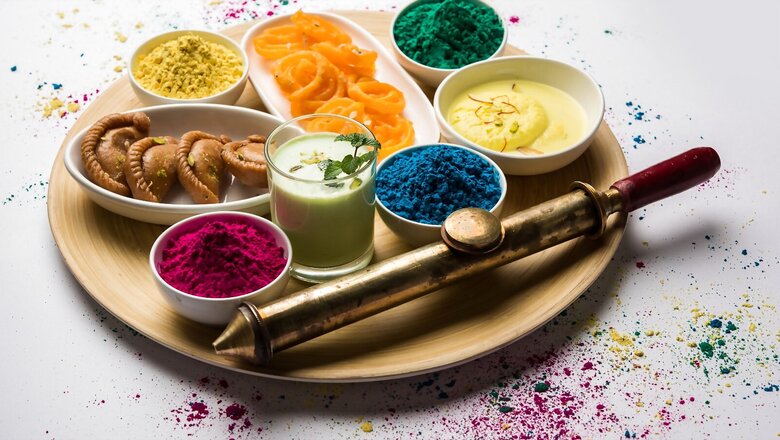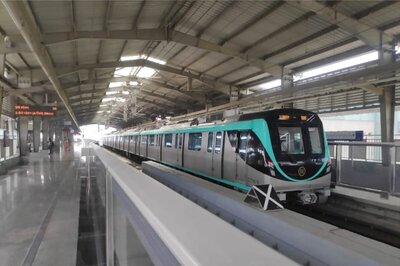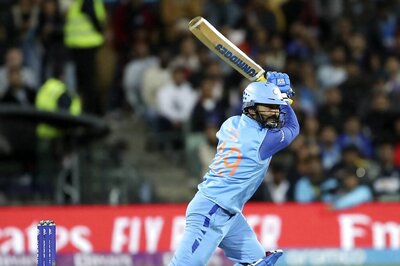
views
I have always been bashful and coy of all the colour and vitality, the boisterousness and the paint, the wetness, the trance and the intoxication of Holi. To me, it has always been the food. Years ago, I was shooting for my food show on the streets of Mathura. Mathura, along the banks of the river Yamuna, is believed to be the homeland and birthplace of Lord Krishna. While the intent was to discover the glorious street food that this holy city has to offer, I found myself bang in the middle of intense Holi celebrations. Celebrations that last not one or two days, but a full week.
On these streets of Mathura, Radha and Lord Krishna had avowedly romanced each other. Mythology describes their shenanigans, and how the little dusky Krishna, jealous of Radha’s fair complexion, smeared colour on her cheeks out of envy. But at the Banke Bihari Temple at Vrindavan, it’s an altogether different Holi. Just a few days before the big colour bash, they celebrate what is called Phoolwali Holi. Everyone gathers at the temple and instead of colours, throw flowers at each other. That’s my kind of Holi, just days before madness erupts and the ghats of Mathura turn into a wild shindig of chroma with sticks, shields, colours and cannons of water, and the streets are full of hungry revellers looking for a hot snack.
On every corner, there are kachoris and jalebis frying in desi ghee. The Mathura kachoris are round and flat with a strong flavour of hing, they are spicy and crunchy and served with aloo ki sabzi. Along with kachoris a plate of freshly fried jalebis is par for the course. Most of North India celebrates Holi in the same fashion. On the streets, with colour and kachori. Of course, there is also a lot of bhang and thandai as well.
Thandai
By itself, thandai is a unique drink. It is cool, refreshing and vitalising. Milk is ground with rich ingredients like cashew, almonds, cardamom, black pepper, poppy seeds, fennel seed (saunf) and rose petals. It’s an unusual combination of tastes especially since pepper and fennel are an unlikely combination in a sweet milky drink. This thandai however turns into bhang, a hallucinogenic when a mixture made from the buds, leaves, and flowers of the female cannabis plant, or marijuana, is added to this rich milk concoction. It is the influence of bhang that makes Holi a celebration of elevated rampage and revelry and creates an appetite for food and sweets that is bottomless. So, then what do you do? Head for the closest place that serves you gujiya.
Gujiya
Gujiya is synonymous with Holi. Similar to the karanji in Maharashtra, or the ghugra in Gujarat or the karjikai in Karnataka, the gujiya is crescent-shaped, flaky pastry filled with sweet stuffing and deep-fried. Traditionally, a gujiya has a filling of sweetened khoya or mawa (milk solids), cardamom and nuts and sometimes sooji and desiccated coconut as well. After deep frying this puff, some mithaiwalas dip these fried pastries into saffron-infused sugar syrup and serve them hot, garnished with pistachio and almond slivers. They are quite soft, juicy, sweet, crunchy and delicious when hot and fresh and considered auspicious on Holi.
Coconut Ladoos
Holi is undoubtedly the festivals of sweets. Another Holi specialty is coconut ladoos. Easy to make with just condensed milk or thadai ingredients and desiccated coconut, these are round sweet balls of pleasure and available nearly anywhere where Holi is being celebrated.
Malpua and Rabri
This is another deadly Holi combination. Malpua, as you know, are traditional North Indian deep-fried pancakes made with wheat flour, sugar and cardamom. Once the pancakes are crisp and golden, they are quickly lifted out of the hot boiling ghee and immersed in a nectar of saffron and sugar syrup, and then served with rabri, rich, sweet, creamy condensed milk. It is sinful and pleasurable as hot and crisp malpua combines with the cold, thick rabri.
Puran Poli
No Holi celebration in a Maharashtrian household is complete without puran poli. This is essentially a sweet stuffed paratha, made by filling soft whole wheat dough with soft-cooked yellow dal, jaggery, cardamom, nutmeg and saffron. Once the dough is stuffed, it is rolled out thin and cooked exactly like a paratha with lots of ghee till it turns crisp and golden brown. Most people eat puran poli as it is or dipped in warm milk. I like my sweet, warm, golden puran poli with spicy kheema or mutton. Sorry, I can get quite blasphemous.
Dahi Bhalla
Besides all these sweets, Holi is also celebrated with chaat and dahi bhallas. Soft balls made of soaked urad and moong dal are fried, and then soaked and dunked in soft, beaten yogurt, and served with a variety of chutneys, garnished with sweet date and tamarind chutney, green spicy chutney and sprinkled with spices. This cold and soft, tangy and sweet dish if well-made can just melt in your mouth.
And I will end this celebration with a few more Holi specials. Like spicy besan sev, namak para or shakar para, which are diamond-shaped fried biscuits made either salty or sweet, and finally Holi bhang ke pakore. These are made with besan, onions, spices and bhang. I guess if you can drink bhang you could eat bhang as well. In any case what more is there to life than celebrations? Eat, drink and be merry.
Kunal Vijayakar is a food writer based in Mumbai. He tweets @kunalvijayakar and can be followed on Instagram @kunalvijayakar. His YouTube channel is called Khaane Mein Kya Hai. The views expressed in this article are those of the author and do not represent the stand of this publication.
Read all the Latest Lifestyle News and Breaking News here
















Comments
0 comment